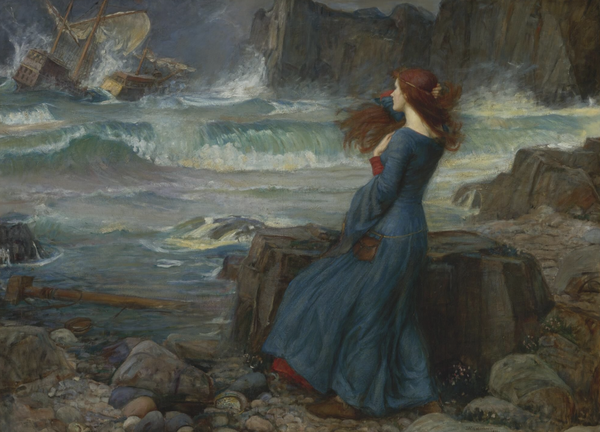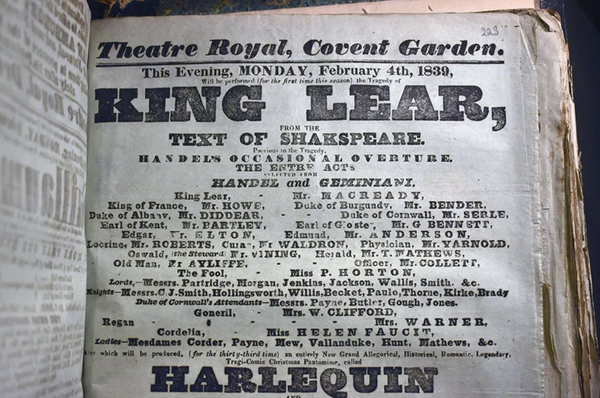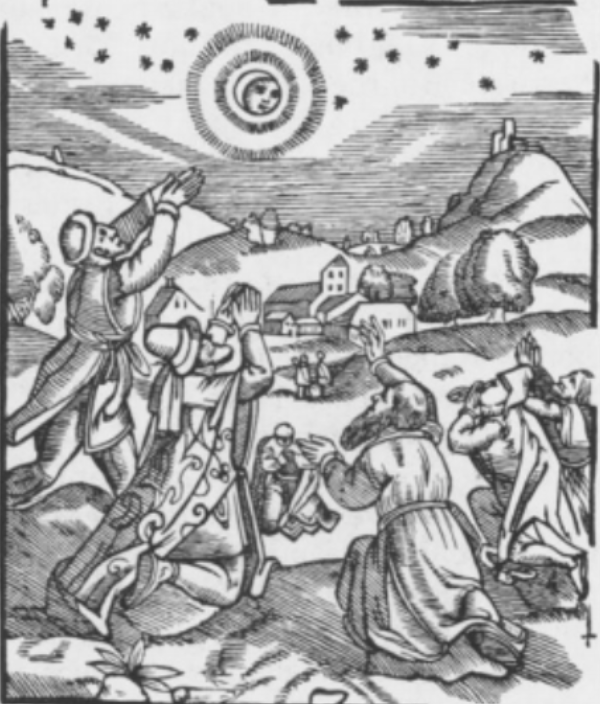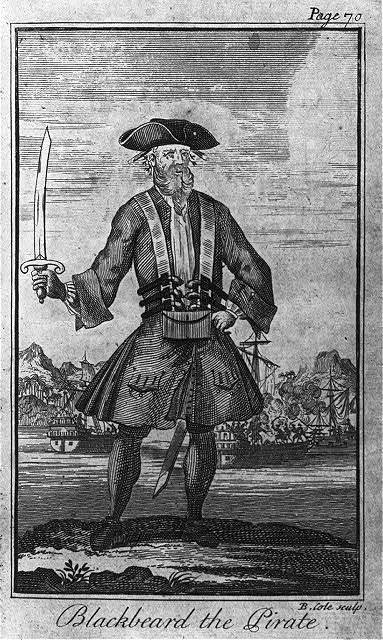Volume 14: January 11, 2021
William Henry Ireland's Forgeries
By London Johns
In 1796, a newly-discovered Shakespeare play, Vortigern and Rowena, appeared onstage in London. At first, the audience watched quietly, expecting a play to rival King Lear or Hamlet. But by the final act, they had erupted into shouts, laughter, and mockery, as actors stumbled through a script that would soon be revealed as a forgery, along with many other recently-discovered letters and legal documents attributed to Shakespeare. These papers, accepted by many who examined them as legitimate manuscripts, were not created by a scholar or accomplished author, but by a teenage boy named William Henry Ireland, who made them to win his father’s approval. Ireland’s success in creating amateur forgeries revealed how fragile the canon of Shakespeare’s works actually was, and how desperate academics of his time were to find new works to add to that canon.
Most of the information available about Ireland’s childhood comes from his Confessions, and because he was prone to lying, many claims that he made about his life are in doubt. For instance, he was apparently born in 1775, though he claimed throughout his life to be born in 1777, and the man he called his father, Samuel Ireland, may have actually been his stepfather (Lynch 79). However, it is almost certain that William Henry Ireland inherited his interest in Shakespeare from Samuel Ireland. Samuel was an engraver, and made several trips across Britain to observe landscapes that he intended to add to his collection of engravings. He was also obsessed with Shakespeare, and believed that manuscripts from his life remained in Stratford-upon-Avon. When he visited Stratford with his son in 1792, he spent much of the trip inquiring about the location of Shakespeare’s papers. Samuel was fixated on this goal to the point of rudeness. When one farmer -- in jest -- declared that he had “made a roaring bonfire” of several baskets of papers with Shakespeare’s name upon them only weeks earlier, Samuel leapt from his chair, exclaimed that the farmer was “not aware of the loss which the world has sustained”, and demanded to search the farmer’s house himself (Ireland 31).
Samuel did not find any of Shakespeare’s papers on this trip. However, despite his lack of success, their visit to Stratford-upon Avon only intensified Samuel’s interest in finding undiscovered Shakespearean manuscripts. He praised Shakespeare constantly. Perhaps that praise was what pushed William Henry to begin forging documents he attributed to Shakespeare. Before this point, William Henry had shown very little academic promise; in his Confessions, he described bringing his father a letter from his headmaster that said that Henry was “so stupid as to be a disgrace to his school” and that educating him was “no better than robbing Mr. Ireland of his money” (Ireland 3). Ireland may have felt he had to win the affection of his father using more drastic means. Frequent conversations with his father about Shakespeare led him to search on his own for manuscripts, and when he examined a deed that contained Shakespeare’s signature, he decided to imitate it “in order to gratify Mr. Ireland,” his father (Ireland 46). He created a fake lease signed by Shakespeare, sealed it with wax rubbed with soot to give it the illusion of age, and presented it to his father. If Ireland’s goal was indeed to please Samuel, he succeeded; William Henry’s father not only mistook the lease for a real manuscript belonging to Shakespeare, but showered his son with praise:
“It is impossible for me to express the pleasure you have given me by the presentation of this deed: there are the keys of my book-case; go and take from it whatsoever you please; I shall refuse you nothing.” (Ireland 51)
This success must have shown William Henry that there was something to gain in forging papers supposedly belonging to Shakespeare, as that lease marked the beginning of his brief but infamous career as a forger.
Over the following months, Ireland created many forged documents, including a declaration that Shakespeare was a protestant, a love letter from Shakespeare to his wife that included a lock of hair, a self-portrait by Shakespeare, and a record of Shakespeare giving “William Henry Ireland” (supposedly one of Ireland’s ancestors) the rights to his papers (Ireland 235). Ireland claimed that all of these papers were gifts from an anonymous gentleman (Ireland 64). Unsurprisingly, not everyone who examined the documents were convinced; Shakespeare scholar Edmond Malone wrote that the sketch was “a miserable drawing of our poet done by himself with a pen, from Martin Droeshout's print of him engraved seven years after his death" (Malone 209). However, many of Ireland’s forged documents were accepted without question, and became quite valuable. Ireland let slip to his father that he had found something even more valuable: an undiscovered Shakespeare play. He showed his play to Samuel in parts, as he “found time to compose it” page by page (Ireland 133), pretending that he was slowly copying it down from the original manuscript. He finished the play within two months, and soon after it was chosen to be shown onstage at Drury Lane.
In the months leading up to the first performance of Ireland’s play, his story began to fall through. Some critics embraced it unquestioningly (James Boswell supposedly fell before the document and cried, “I now kiss the invaluable relics of our bard: and thanks to God that I have lived to see them!”) (qtd. in Lynch 83). Others recognized a lack of artistry in the play, commenting that Shakespeare must have been very young when he wrote it -- unsurprisingly, as Ireland himself was underage (Ireland 139). One commentator mocked Ireland’s over-the-top imitation of Elizabethan spelling with his own fake letter from Shakespeare to “Missteerree Beenjaammiinnee Joohnnssonn,” inviting him “too eatte sommee muttonne choppes andd somme poottaattoooeesse” (qtd. in Lynch 82). Edmond Malone, probably the most outspoken of Ireland’s critics, printed a notice to pass out outside of the theater that claimed that Malone would soon prove that the play was a forgery (Ireland 142). In response, Samuel printed a notice that the audience should not enter the theater expecting to see a forgery, but should draw their own conclusions from the play. However, the damage had been done, and most of the audience was aware of the controversy by the time the play began.
The response to the play itself was even more ruinous. According to Ireland, the show was sold out, and the first few acts passed without interruption. However, midway through the play, an actor named Mr. Kemble -- likely himself doubtful about who actually wrote the play -- melodramatically stressed the line “and when this solemn mockery is o’er”, suggesting that he “solemn mockery” to which he referred was the play itself (Ireland 158). The audience burst into laughter that Ireland recalls lasting “ten minutes” (Ireland 158). Vortigern and Rowena was considered a failure, and the play was not performed again until 1997 (Lynch 83).
The Vortigern and Rowena disaster -- as well as Malone’s response, in which he listed evidence that each of Ireland’s documents were forgeries -- was the beginning of the end for Ireland’s career in forgery. Ireland did not immediately stop creating forged documents -- in fact, he quickly began writing a second fake Shakespeare play, Henry II. But the controversy surrounding Ireland’s forgeries was beginning to make him nervous. He was afraid that someone would discover that he had written every one of the documents he had brought to light, and guilty that his father was forced to take on the majority of the criticism (238). At the same time, the gullibility of scholars who had believed Ireland’s lies may have convinced him that if he was discovered as the author of the play, he would be celebrated as a literary genius -- after all, even a passable imitation of Shakespeare was worthy of celebration. He gradually decided to come forward of his own free will before he was forced to by someone else. Ireland confessed to his father in a letter; Samuel did not believe him, refused to compare his handwriting to the handwriting in the forged documents, and insisted that he knew that the manuscripts had belonged to Shakespeare himself (260). Then Ireland printed a short pamphlet announcing his forgeries, which was also received with disbelief from Samuel and the general public. Finally, he published a 400-page book called The Confessions of William Henry Ireland: containing the particulars of his fabrication of the Shakespeare Manuscripts, which was at last considered adequate evidence of his guilt.
What became of Ireland after his confession? Critics attacked him -- one writer called for him to be hanged (Stewart). William Henry claimed that they were just jealous because “they were deceived by a boy” (qtd. in Stewart). He continued to write books in various genres, but none of them were received with the same enthusiasm as his fake Shakespeare documents. Ireland sold his Shakespeare papers to a book collector, but soon realized that they were his most reliable source of money. He began making new copies of the papers to sell to other collectors, claiming that they were the originals -- forgeries of his own forgeries. Samuel Ireland stopped contacting his son entirely after his confession, but he also never admitted to believing that William Henry was guilty, and went to the grave believing that the existence of Ireland’s manuscripts was an unsolved mystery.
Though Ireland’s forgeries were probably the most famous forgeries of Shakespeare, they were not the only ones. In the mid-19th century, John Payne Collier forged a second folio edition of Shakespeare’s works, with commentary supposedly written by a reader in the 17th century; some forgeries of Shakespeare’s signature date back to the 1600s (Groom; Shakespeare). As Ireland himself wrote in his Confessions, “it is extraordinary to observe how willingly persons will blind themselves on any point interesting to their feelings” (134). Ireland was not a genius, not an expert, and not even a particularly talented writer at the time when he created manuscripts attributed to Shakespeare. He faked his first document as a teenager; even he was surprised that until Vortigern and Rowena, his forgeries were received with amazement and support. What was it about his work that convinced its readers that he was Shakespeare and supposedly caused James Boswell to fall to his knees in awe? Other than his naive bravado, probably nothing that Ireland himself did, but instead an audience that, like Ireland’s own father, saw only what they wanted to see in Vortigern and Rowena’s pages.
Works Cited
Groom, Nick. “Review of John Payne Collier: Scholarship and Forgery in the Nineteenth Century.” Victorian Studies, vol. 49 no. 2, 2007, p. 372-374. Project MUSE muse.jhu.edu/article/218893.
Ireland, Samuel. “William Shakespeare.” The Met, The Metropolitan Museum of Art, 2021, www.metmuseum.org/art/collection/search/708337.
Ireland, W. H. (William Henry), 1777-1835, and Richard Grant White. The Confessions of William Henry Ireland: Containing the Particulars of His Fabrication of the Shakespeare Manuscripts. A new edition, with an introduction by Richard Grant White and additional facsimiles. New York: James W. Bouton, 1874.
Lynch, Jack. “William Henry Ireland's Authentic Forgeries.” The Princeton University Library Chronicle, vol. 66, no. 1, 2004, pp. 79–96. JSTOR, www.jstor.org/stable/10.25290/prinunivlibrchro.66.1.0079. Accessed 11 Jan. 2021.
Malone, Edmond. An Inquiry Into the Authenticity of Certain Miscellaneous Papers and Legal
Instruments, Published Dec. 24, 1795 and Attributed to Shakespeare, Queen Elizabeth and Henry, Earl of South-Ampton. Illustrated by Fac-Similes ... and Other Authentick Documents: in a Letter Addressed to the Right Hon. James, Earl of Charlement. Cadell, 1796, Google Books, books.google.com/books?id=zWJXAAAAcAAJ.
McLoone, Juli. “Shakespeare’s Life after Death: The Ireland Shakespeare Forgeries.” University of Michigan Library, University of Michigan, 25 Apr. 2016, apps.lib.umich.edu/blogs/beyond-reading-room/shakespeare%E2%80%99s-life-after-death-ireland-shakespeare-forgeries.
Shakespeare, William. “Signature of William Shakespeare [manuscript]”. 16th-17th century. Hamnet; Folger Shakespeare Library. https://luna.folger.edu/luna/servlet/s/20ovez
Stewart, Doug. “To Be...Or Not: The Greatest Shakespeare Forgery.” Smithsonian.com, Smithsonian Institution, 1 June 2010, www.smithsonianmag.com/history/to-beor-not-the-greatest-shakespeare-forgery-136201/.
Werner, Sarah. “Four States of Shakespeare: the Droeshout Portrait.” The Collation, Folger Shakespeare Library, 10 June 2014, collation.folger.edu/2014/06/four-states-of-shakespeare-the-droeshout-portrait/.
Note: Those curious about forgeries and forgers of Shakespeare’s work may find Arthur Phillips’s 2011 novel The Tragedy of Arthur intriguing.







